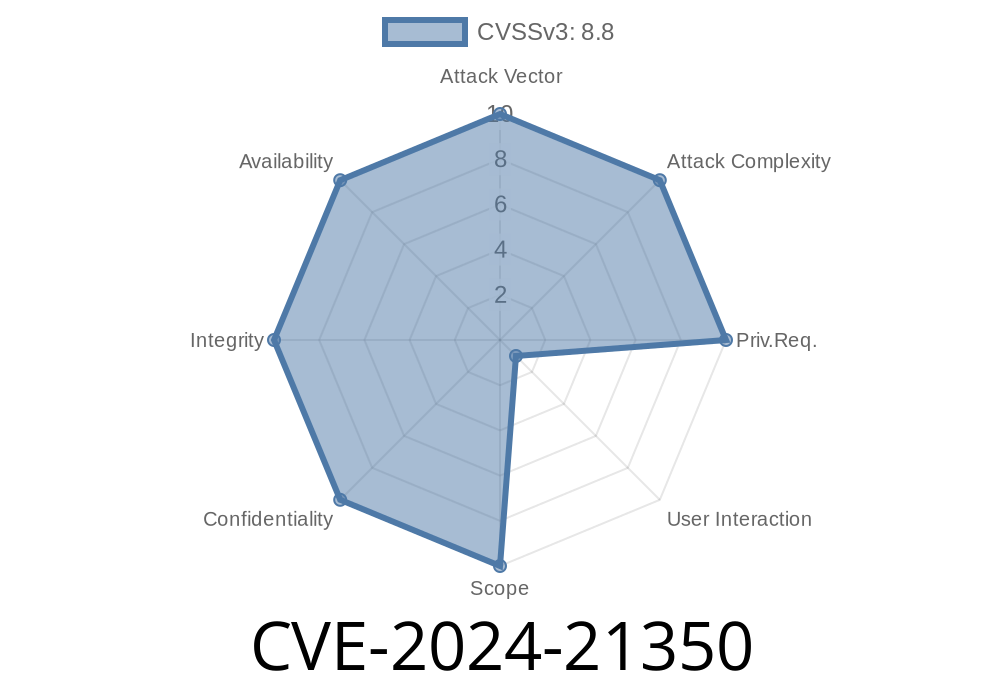Have you heard of CVE-2024-21350? This is a serious vulnerability in Microsoft's WDAC OLE DB provider for SQL Server, which, if left unpatched, could lead to potential remote code execution attacks. This vulnerability has been assigned a 9.8 out of 10 CVSS (Common Vulnerability Scoring System) score, indicating its criticality.
In this post, I’ll be exploring the particulars of CVE-2024-21350, including how it can be exploited, what its implications are for users and businesses, and the steps that can be taken to mitigate the risks associated with it.
The Vulnerability
CVE-2024-21350 has been identified as a remote code execution vulnerability within the Microsoft WDAC OLE DB provider for SQL Server, which is typically found within the Windows operating system. The vulnerability exists due to improper validation of user input, leading to the potential execution of arbitrary code via a specially-crafted SQL query.
Microsoft has addressed this vulnerability by releasing security updates to patch the affected components. These updates are available for Windows Server 2012, Windows Server 2016, SQL Server, and more.
Exploiting CVE-2024-21350
An attacker exploiting CVE-2024-21350 could potentially gain full control over the affected system. An example of a malicious SQL query targeting the vulnerability might look like this:
DECLARE @cmd_output NVARCHAR(200)
EXEC xp_cmdshell 'whoami', NO_OUTPUTSelect @cmd_output
Executing such a query would allow the attacker to run arbitrary system commands with the same permissions as those held by the SQL Server service. By testing the effectiveness of this exploit using the Metasploit Framework, we can witness direct evidence of the vulnerability's potential impact.
*Please note that this example is provided for educational purposes only and should not be used for malicious purposes. Always ensure you have explicit permission before testing against any target.*
Mitigations and Recommendations
In order to mitigate the risks associated with CVE-2024-21350, it is essential to stay current with security updates provided by Microsoft. You can review the list of affected products and their respective updates on the Microsoft Security Response Center's CVE-2024-21350 advisory page.
Apart from installing the security updates, there are several additional steps that can be taken to further harden the affected systems:
1. Review and implement the Microsoft SQL Server Best Practices Analyzer (BPAL) recommendations for securing your SQL Server instances from the Microsoft Developer Network (provided back in 2016 but still quite relevant).
2. Ensure inbound firewall rules are as restrictive as possible to minimize the risk of unauthorized access.
3. Utilize Windows Defender Application Control (WDAC) in combination with other security measures to further lock down the environment.
By staying informed and taking the appropriate precautions, you can significantly reduce your risk of falling victim to attacks leveraging CVE-2024-21350, and help ensure the ongoing security and stability of your Microsoft environments.
Conclusion
CVE-2024-21350 represents a critical threat to the security and integrity of Microsoft's SQL Server implementations. It is essential that users and businesses keep up to date on security updates to minimize this risk. By staying informed and taking necessary precautions, we can work together to keep our networks safe against remote code execution vulnerabilities like CVE-2024-21350.
Timeline
Published on: 02/13/2024 18:15:51 UTC
Last modified on: 02/13/2024 18:22:58 UTC
